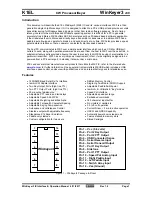
ASV115
Air volume parameters
(Room positive pressure
supply
exhaust
)
Air volume, setpoint
c
qV.s
= 40%
4 V
Master (supply air)
min
= 20%
max
= 100%
nom
= 1000 m³/h
Master (exhaust air)
min
= 20%
max
= 100%
nom
= 900 m³/h
c-factor 100
(
= 1.2 kg/m³)
Air volume, actual value, master
r
qv
= 40%
4 V
400 m³/h
Air volume, actual value, master
r
qv
= 40%
4 V
360 m³/h
Air volume parameters
(Room negative pressure
supply
exhaust
)
Air volume, setpoint
c
qV.s
= 40%
4 V
Master (supply air)
min
= 20%
max
= 100%
nom
= 1100 m³/h
Master (exhaust air)
min
= 20%
max
= 100%
nom
= 1000 m³/h
c-factor 100
(
= 1.2 kg/m³)
Air volume, actual value, master
r
qv
= 40%
4 V
440 m³/h
Air volume, actual value, master
r
qv
= 40%
4 V
400 m³/h
Example 2: VAV (Master-Slave)
Variable air volume control with supply- and exhaust-air controller in
master–slave configuration, commanded by a room temperature
controller for rooms with high comfort and control requirements. The
master–slave configuration allows an equal-percentage relationship
between the supply- and exhaust-air volumes.
www.sauter-controls.com
11/13
The command signal, e.g. from a room temperature controller, is
connected to the master controller. The command signal shifts the
parameterised air volume values in the range from
min
to
max
.on
the master controller. The actual value signal of the master control-
ler is specified as the command signal for the slave controller. This
type of connection is also known as "schedule control". The result is
that if there are changes to the upstream pressure in the air network
due to fluctuations in duct pressure control, these disruptions can
be detected and transmitted directly to the slave controller. This
guarantees an equal-percentage relationship between the supply-
and exhaust-air controllers. The command signal or the actual value
signal r
qv
from the master controller can be connected in parallel to
several slave controllers.
The required operating air volume between
min
and
max
is pa-
rameterised on the master controller. On the slave controller,
min
is set to 10% and
max
is set to 100%. Alternatively,
min
and
max
can be set so that
min
(slave)
<
min
(master) and
max
(slave) >
max
(master). It should be ensured here that
nom
is
parameterised with the same value for the master and slave con-
trollers to ensure synchronicity of the controllers. If the
min
and
max
values on the supply- and exhaust-air sides are parameter-
ised differently, undesirable negative or positive pressure may
occur in the room.
Setting for room positive pressure =
supply
exhaust
Setting for room negative pressure =
supply
exhaust
Note
With this type of room pressure generation, the resultant room
pressure depends on the size of
. Defined room pressures can
be achieved using room pressure controllers and the
function.
For priority control, the digital inputs on the supply and exhaust air
controllers are activated in parallel via switching contacts. The
desired parameters for
min
,
max
and
mid
are set using software.
This method of operation is also suitable for constant air volume
control, and this function is also achieved by a constant command
signal at the setpoint input.






























